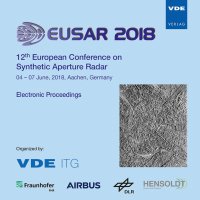Some new Results on L1 Minimizing Nullspace Kalman Filtering
Konferenz: EUSAR 2018 - 12th European Conference on Synthetic Aperture Radar
04.06.2018 - 07.06.2018 in Aachen, Germany
Tagungsband: EUSAR 2018
Seiten: 6Sprache: EnglischTyp: PDF
Persönliche VDE-Mitglieder erhalten auf diesen Artikel 10% Rabatt
Autoren:
Loffeld, Otmar; Hage, Dunja Alexandra; Conde, Miguel Heredia (Center for Sensorsystems, ZESS, University of Siegen, Germany)
Wang, Ling (Key Lab. of Radar Imaging and Microwave Photonics, Nanjing University of Aeronautics and Astronautics, China)
Inhalt:
The SAR image generation from raw data can be seen as a decoding problem of raw data which has been encoded by the SAR sensor, where the coding scheme depends on the sensor and the sensing geometry. Compressed sensing (CS) decoding approaches, implicitly model the forward encoding or sensing process in matrix vector form with a sensing matrix, where the dimensions of this matrix grow proportionally with the product of raw data samples and finally wanted image pixels. Especially when applied to Synthetic Aperture Imaging Processing we then face the necessity of handling extremely large data vectors and even larger sensing matrices. Classical focussing/decoding approaches conceptually invert the system of equations, introducing matched filter concepts making use of pseudoinverses. CS concepts under the assumption of images which are sparse in some basis or in combinations of bases promise a reduction of raw data samples without sacrificing resolution or vice versa an improved resolution or signal to noise ratio if the number of raw data samples is not reduced. Consequently the Cramer Rao Bound assuming sparsity of the image to be reconstructed is governed by the number of non-zero coefficients in its sparse description which under an oracle given knowledge of the sparse support converts the forward sensor model into an even overdetermined system of equations which would allow a smaller Cramer Rao Bound than without sparsity assumption. Basis pursuit approaches to CS decoding employ a constrained l1-minimization for the wanted (sparse) image vector to be reconstructed where the constraining data fidelity term models the SAR sensor’s encoding, which requires a burdensome matrix vector multiplication in each iteration step. Hence algorithmic issues in realizing the CS decoding play a crucial and decisive role. This paper presents some new results on recursive l1- minimization by Kalman filtering. We consider the l1-norm as an explicit constraint, formulated as a nonlinear l1- observation of the state to be estimated. Interpreting a sparse vector to be estimated as a state which is observed from erroneous (undersampled) measurements we can address time- and space-variant sparsity, any kind of a priori information and also easily address nonstationary error influences in the measurements available. Rather than estimating the full n-dimensional vector of unknowns, the presented approach works on a nullspace basis and only estimates the nullspace vector of dimension n-m, where m is the dimension of the observation vector. Due to this and depending on m, the computational burden of this nullspace vector estimation approach may be considerably smaller in comparison with Chambolle and Pock’s Primal Dual Algorithm or many other algorithm estimating the full n-dimensional vector of unknowns. In fact for mildly undetermined systems of equations the computational complexity of the Nullspace Kalman Filter can beat Chambolle and Pock’s primal dual algorithm and approaches the OMP complexity, which depends on the sparsity, whereas it does not for the Nullspace Kalman filter.


